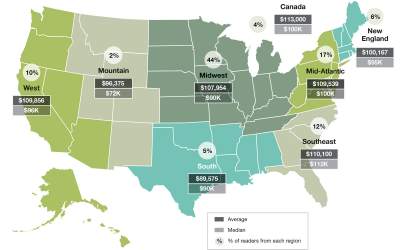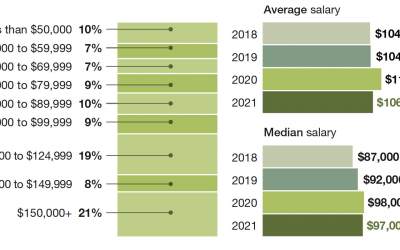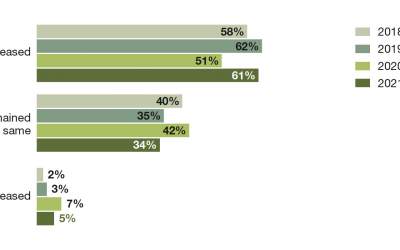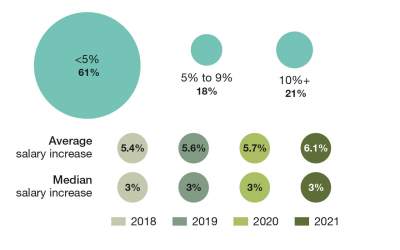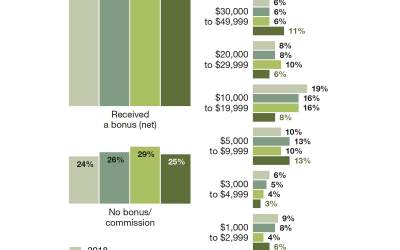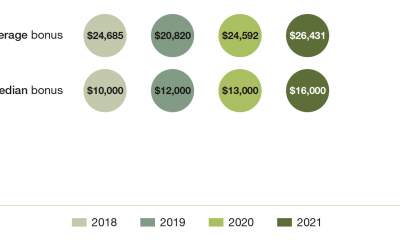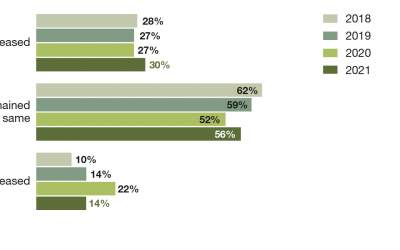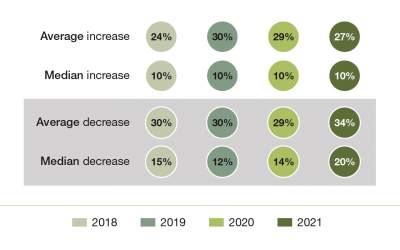Materials Handling Salary Survey 2021: Amid challenges satisfaction stays strong
Our annual salary survey for materials handling professionals asks about issues including pay, staffing trends, stress levels and job satisfaction. Even with pandemic disruption and robust e-commerce growth posing constant challenges, compensation and satisfaction stayed strong.
Even in a year where Modern readers dealt with everything from lingering pandemic impacts to unrelenting e-commerce fulfillment pressures, significant positives could be found in the results of our annual salary survey.
According to the latest salary survey, while average base salary declined compared to last year, more than 60% of 2021 respondents reported their base salary increased, and the vast majority—93%—said they would recommend the materials handling profession to others, nearly as high as the 96% who said so last year.
Additionally, the heightened problems our readers reported last year about staffing concerns like less hiring taking place, or layoffs and hiring freezes, moderated this year.
Let’s talk salary
Average base annual salary for 2021 was $106,775, down from 2020’s average of $114,773, but better than $2,000 higher than the 2019 and 2018 survey averages. The median salary this year is $97,000, down from last year’s median, but topping the medians for 2019 and 2018. Each year brings a different respondent mix to our reader survey, so some fluctuation is inevitable.
This year, our survey, which was conducted by Peerless Research Group during August 2021, garnered 165 qualified respondents. Primary job function included warehouse managers, directors and supervisors (36% of respondents); industrial engineers and plant engineers (14%); plant managers, directors and supervisors (9%); company managers and senior executives (19%); 2% in purchasing roles; and 20% in other roles.
Company management, on average, receives the highest compensation at $145,772 annually, though this was down from last year. The average salary for engineering respondents came in at $109,750; DC managers at $105,668; purchasing roles at $99,785; and plant managers/supervisors at $92,283.
Although the average base salary trended down compared to last year, 61% of respondents this year said their base salary increased, which is up from a 51% response on that question last year. So overall, the respondent pool last year enjoyed a higher base salary, but a solid majority this year experienced an increase.
Of those reporting some increase in base salary, 61% received an increase of less than 5%. Meanwhile, 18% of respondents got 5% to 9% increases, and 21% reported an increase of 10% or more.
Most respondents (74%) report receiving some type of bonus or commission pay. This year, the average bonus/commission came to $26,431 and the median is $16,000, which beat out last year’s average of $24,592, as well as the median of $13,000.
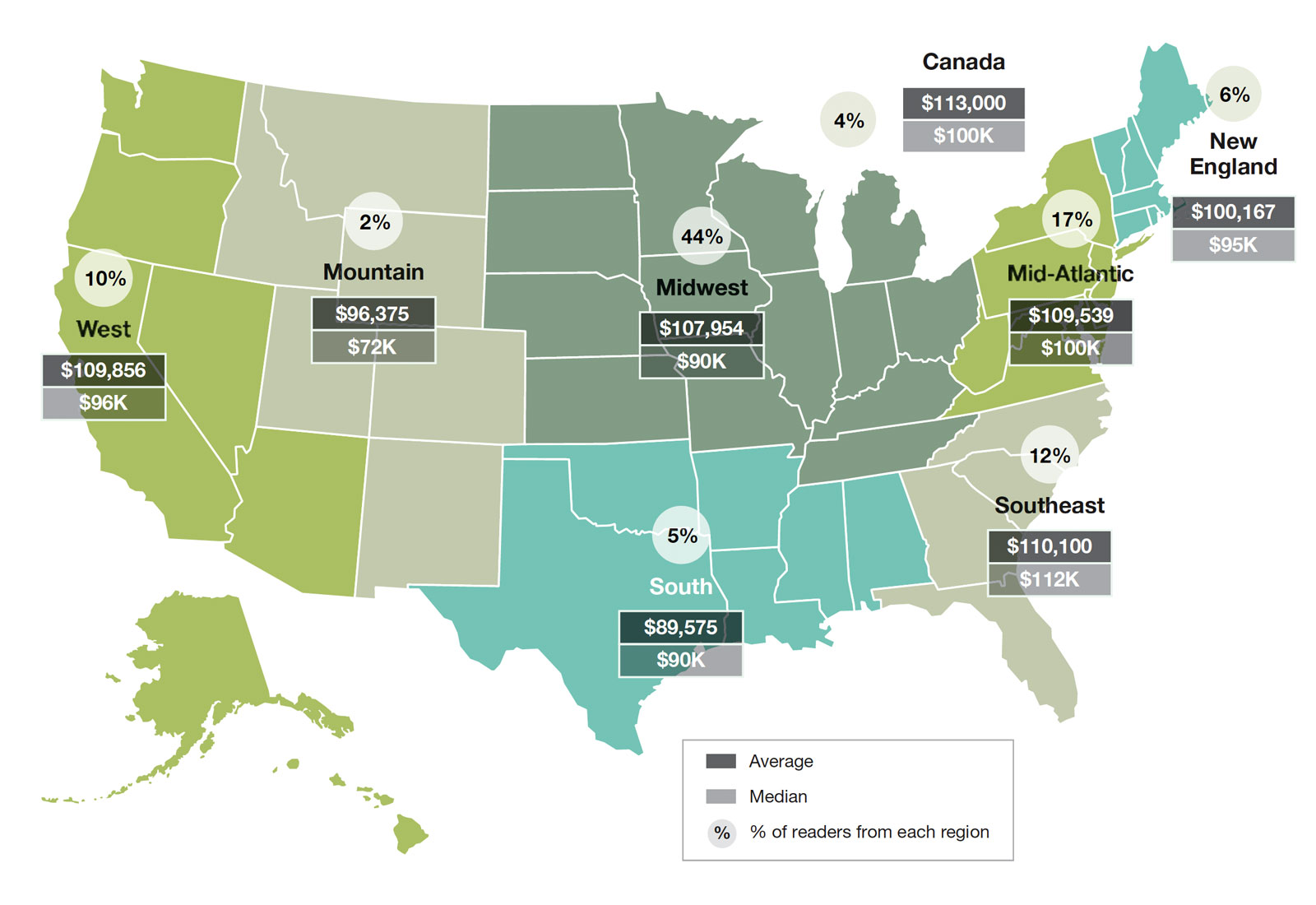
This year, 30% of respondents said their bonus plan increased compared with 2020, up from 27% the previous two years. Of those who reported an increase, the average increase was 27%, and the median increase was 10%, nearly even with last year.
The map graphic breaks average and median salaries down into eight regions. This year, every region except Mountain and South have average salaries that exceed $100,000, with the top two regions being Canada ($113,000 average) and the Southeast ($110,100 average).
Overall, compensation remains healthy, though not at the base salary average reported by last year’s respondents. Perhaps this compensation picture helps explain the strong job satisfaction level seen again in this year’s results. Ninety-one percent this year said they like their current job, down 1% from last year’s 92%, and also higher than the 85% response from two years ago.
Digging deeper on salaries
Like in any industry, factors like years of experience, education level and level of management responsibility all can influence pay and salary levels.
Years of experience is a key factor, with seasoned managers earning more. This year, those with 30-plus years in the profession have an average salary of $120,500, and a median of $116,000. That compares with an average of $62,917 for those with less than five years, and a median of $82,500. Last year, the differences were similar.
The survey also asks about how many companies respondents have worked for, with generally higher pay for those who’ve moved around more, but not always. For example, those who’ve worked for more than five companies had an average salary of $121,218, well over those who’ve worked for one to three companies. However, those who’ve worked for four companies had an average salary of $156,414.
The average number of years at a person’s current employer stood at 10.1 years this year, down a bit from last year’s 10.3 years, and nearly even with the 10.0 average time at employer in 2019. Some stay with a company for decades, with 24% this year having 20-plus years with the same employer.
As might be expected, those with supervisory responsibilities (77% of all respondents in 2021) earn more. This year, those with management roles averaged $116,661 in salary versus $87,147 if not a supervisor.
Budgetary responsibilities also contribute to higher average salaries. The 77% of respondents this year who have budgetary responsibilities had an average salary of $116,661, compared to $87,147 for those who do not.
In the survey’s questions on demographics, we ask about gender and education level, as well as other factors such as company revenue ranges. People with advanced degrees earn more, with those having MBAs averaging $160,000 in salary, college graduates averaging $113,665, and those with two-year degrees averaging $90,143.
Generally, those from larger companies earned more, but there seems to be sweet spot in the respondent mix this year, with the highest average salary ($133,220) for those who work at companies with annual sales of between $250 million to $499 million.
When it comes to gender-related findings, 10% of respondents this year are female, and 90% male. For these female respondents, the average salary this year was $106,293, compared with $114,552 for the male respondents. However, that average salary for women professionals this year climbed significantly from an average of $88,185 last year and is the highest in the past four surveys.
Staffing indicators improve
While our salary survey does not ask about pandemic impacts directly, it does ask about hiring and staffing trends respondents are experiencing.
Some of these findings (see chart above) are now trending in a better direction compared with 2020, when respondents reported higher than usual issues related to being able to add personnel, approve overtime, or dealing with pay cuts or wage freezes.
The trend is perhaps not unexpected, since in 2020 more regions and industries dealt with pandemic-related facility shutdowns and disruptions compared to 2021. While pandemic concerns are not yet gone, our 2021 findings point to an improved environment for being able to do things like add more staff.
For example, last year, 45% of respondents reported a hiring freeze at their company. This year, by contrast, 23% said they experienced a hiring freeze, same as the level in 2019. Similarly, last year, layoffs were experienced by 33% of respondents, but that response dropped back to 26% this year, although it is still 7% higher than in 2019.
Perhaps the most reassuring finding this year is the 71% of respondents who said their company has been able to hire or add personnel, well over last year’s 45%. Similarly, last year, 34% reported reduced overtime at their company, while this year, only 19% did.
Again, it’s likely that the earlier phases of the pandemic in 2020, which involved more shutdowns and disruptions than seen this year, made 2020 a particularly challenging year on the staffing and hiring front. One note, our survey doesn’t ask if the hiring/staffing has reached an optimal level, just that hiring taking place.
Another encouraging finding in regard to staffing is that the turnover rate for 2021 averaged 10.1%, a decrease from 2020’s average of 12.3%, and more in line with turnover rates from 2019 and 2018.
These improved findings on the staffing issues may help explain why respondents appear to have be generally happy in their roles, and continue to believe in materials handling careers.
This year, 91% of respondents said they like their current job, and when asked, “would you recommend the profession to others,” 93% said yes—3% lower than in 2020, but 1% higher than in 2019.
However, on a related question asking about level of satisfaction on a spectrum from “not at all” satisfied to “extremely” satisfied, the levels stayed steady, although this year, 48% said they were “very” satisfied, down from last year’s 50%.
In any profession, people often look for career advancement or change, even with healthy satisfaction indicators as a whole, and the materials handling industry is no different.
With that in mind, this year, 7% are “actively” looking for a change, down from 12% last year. However, 34% say they are “always open to other possibilities,” 7% higher than last year, while 36% say they “happy where I am,” down from 43% in 2020.
When asked why they are looking, we presented multiple choices and percentages across most remained fairly stable. However, a marked increase was apparent in those saying the trigger was compensation (57% this year versus 48% in 2020).
Managing the flow of goods and fulfillment/production work in warehousing and manufacturing is a high-paced, challenging job. That makes work exciting for many, but can be a source of stress. And stress levels are creeping up.
This year, 15% described their job as “extremely” stressful, another 33% said it was “very” stressful, and 45% agree it is “somewhat” stressful. And 5% said it was “not very stressful,” and 2% see it as “not at all” stressful. Last year, 15% called it extremely stressful; 28% said “very stressful;” and 45% say “somewhat” stressful. Thus, the increase was in those seeing their role as “very” stressful—up 5%.
When we asked about what contributes to job stress for those in the “extremely” or “very” stressed categories, top answers (multiples permitted) were: workload (46% and up 3% from last year); not enough people to get the job done (43%, down from 51% in 2020); and “not enough time to get work done” (39%, down 3% vs. 2020).
On a related question, we asked about stress level versus two years ago, and 50% called it more stressful, a tad higher than last year’s 48%. However, this year 15% said work had become less stressful versus two years ago, up from 9% who felt that way last year.
Perhaps to those in some other industries or careers, the level of compensation seen in the materials handling world seems like nothing to complain about, but then again, it’s no easy mission to keep a fulfillment center operation or manufacturing operation on track with material flow and throughput goals. There is plenty of stress in the profession, but as our survey indicates, rewards as well.

Article Topics
Packaging News & Resources
Registration open for Pack Expo International 2024 Pack Expo East has largest show to date Optimize Parcel Packing to Reduce Costs CMC Packaging Automation North America unveils Tech Center in Atlanta PACK EXPO East brings latest packaging technologies to Philadelphia Loftware’s cloud-based labeling solutions take center stage Flexcon unveils its innovative bin solutions More PackagingLatest in Materials Handling
Beckhoff USA opens new office in Austin, Texas Manhattan Associates selects TeamViewer as partner for warehouse vision picking ASME Foundation wins grant for technical workforce development The (Not So) Secret Weapons: How Key Cabinets and Asset Management Lockers Are Changing Supply Chain Operations MODEX C-Suite Interview with Harold Vanasse: The perfect blend of automation and sustainability Consultant and industry leader John M. Hill passes on at age 86 Registration open for Pack Expo International 2024 More Materials HandlingAbout the Author
Subscribe to Materials Handling Magazine

Find out what the world's most innovative companies are doing to improve productivity in their plants and distribution centers.
Start your FREE subscription today.
April 2024 Modern Materials Handling

Latest Resources


